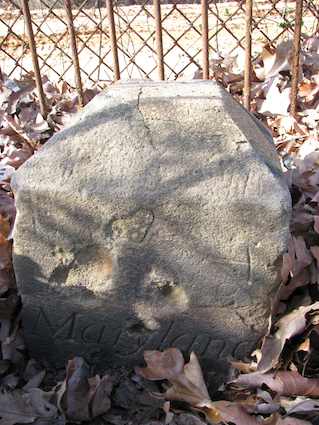Most of you will probably want to skip down a bit and start reading at the map.
Longtime readers may remember when I went down to Texas for my grandmother’s 100th birthday party. Well, sorrowfully Bernice Sylvester McGaughy passed away a few days ago. She was 102 years old and in good health both physically and mentally until about three weeks ago. We’re sad of course but we take solace in knowing that we should all be so fortunate. She lived well for a very long time and then went quietly at the end.


I told my children about the amazing things she’d seen during her lifetime. The Wright Brothers flew their famous airplane barely five years before her birth. And she lived more than forty years after men landed on the moon; things of that nature. Her siblings all lived into their nineties except for one brother who died of influenza during the Great Pandemic of 1919. That’s ancient history to us today. Yet, she survived all the way to 2011, the last of her generation.
Making Arrangements
It’s an odd confluence of events that will lead to her burial at the Fort Lincoln Cemetery in Brentwood, Maryland. I won’t focus on the details except to note that my grandparents were natives of Texas and had lifelong associations with the Lone Star State. Nonetheless my grandfather found himself in a Maryland suburb of Washington, DC when he passed away suddenly in 1958. Now my grandmother will join him there.
I am the only member of the immediate family that lives in the area. That’s why I went to the cemetery on Saturday to sign various documents required by the State of Maryland. Then I confirmed the location of the plot. Death and taxes may be the only certainties in this world, but even death can’t stop the perpetual wheels of bureaucracy. Her funeral was in San Antonio, TX last week where most of the family said their goodbyes. Thus I will probably be the only person graveside, once I work out those details.
Now To the Fort
So I came to Fort Lincoln Cemetery, a place I’d never seen before, yet so remarkably close to my home by distance. And here I’ll shift the focus. I’ll move away from the person family story to topics of more general interest to the Twelve Mile Circle community. I discovered a place with a greater number of historical sites than practically any other location I’ve seen of comparable size. Those I examined after finishing with my personal business.
It started to sink in when I looked on Google Maps to chart my course that morning. I noticed that the cemetery followed the Maryland side of the border adjacent to the District of Columbia for an extended distance.
Along the Boundary
Are you thinking what I’m thinking? Original DC boundary stone, anyone?

I looked online. Sure enough the Northeast Stone #7 fell within the grounds of the Fort Lincoln Cemetery. I spotted it with ease. It’s been a tough winter so I cleared fallen leaves and wind-blown trash away from the stone. Then I could get a decent shot.
Notice that “Maryland” has been carved into the base. This stone is in pretty rough shape, though. It doesn’t look like the last 200+ years have been as kind to NE7 as compared to some of the other boundary stones I’ve cataloged. I got the feeling that few people ever venture to this stone. A rusty wrought iron cage protect it and a nasty chain-link fence ran behind it.
An Actual Fort
This hillside served as an attractive location for fortifications, and the photograph captures two distinct historical periods.

British forces invaded the United States during the War of 1812. They also sought to destroy the new nation’s capital city. So they sailed up the Patuxent River and pushed inland towards Bladensburg. They quickly routed American troops assembled in defense except for a force of four hundred marines at the top of this hill (up by the building in the background). The British prevailed after fierce hand-to-hand combat, removing the last opportunity for the American forces to save Washington. British troops marched unopposed into the city that evening. Then they torched the public buildings including the Capitol and the White House.
The mounds in the foreground with the large American flag and the artillery are the remnants of Battery Jameson of Fort Lincoln. Those formed part of the ring of Civil War fortifications that created the Defenses of Washington. Construction began in the summer of 1861 and the fort was named in honor of the sitting president, Abraham Lincoln upon its completion.
President Lincoln rode out to Fort Lincoln several times during the war. I have visited other remnants of these fortifications including Fort C.F. Smith and Fort Reno so it was nice to see a Maryland example too. Post-war development erased most of the visible signs of these earthwork forts as the District and its surrounding areas urbanized and expanded. The remarkable preservation of Fort Lincoln’s remnants probably owes its survival to its placement within the eponymous cemetery. What’s a Fort Lincoln Cemetery without a Fort Lincoln?
The Colonial Era
The recorded history of this tract goes back much further, all the way back to the earliest days of colonial Maryland. Lord Baltimore granted the surrounding countryside to George Conn. Then it remained within the Conn family for another two centuries.

This structure is called the Old Spring House, designed to cool dairy products using the ambient temperature of fresh spring water. Reputedly it is also one of the oldest buildings in Maryland. It dates to circa 1683. Abraham Lincoln supposedly took cool drinks of water here during his frequent visits to the fort during the Civil War.
Fort Lincoln is a remarkable cemetery. I take comfort knowing that my grandparents rest amid great history and geography. No, it’s not Texas but it seems to be the next best thing.

Leave a Reply